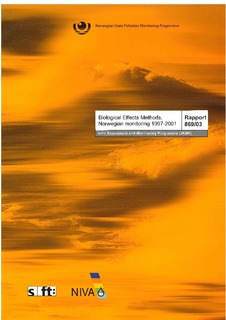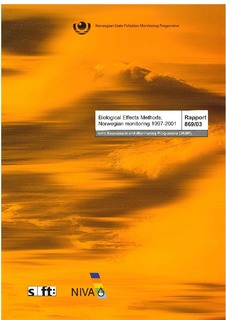| dc.contributor.author | Ruus, A. | nb_NO |
| dc.contributor.author | Hylland, K. | nb_NO |
| dc.contributor.author | Green, N. | nb_NO |
| dc.contributor.other | Green, N. - Project manager | nb_NO |
| dc.coverage.spatial | Finnmark | nb_NO |
| dc.coverage.spatial | Oslo | nb_NO |
| dc.date.accessioned | 2014-08-01T10:47:53Z | |
| dc.date.available | 2014-08-01T10:47:53Z | |
| dc.date.issued | 2003 | nb_NO |
| dc.identifier | 4649 | nb_NO |
| dc.identifier.isbn | 82-577-4313-5 | nb_NO |
| dc.identifier.issn | 1894-7948 | nb_NO |
| dc.identifier.uri | http://hdl.handle.net/11250/212019 | |
| dc.description | Årsliste 2003 | nb_NO |
| dc.description.abstract | The results for application of biological effects methods in JAMP 1997-2001 are presented and included the monitoring of cod and/or flatfish (15 stations) along the coast of Norway from Oslo to Bergen, Lofoten and Varangerfjord. The methods evaluated are quantification of bile-concentrations of 1-OH-pyrene (pyrene metabolite), activity/inhibition of the enzyme d-aminolevulinic acid dehydrase (ALA-D), activity of 7-ethoxyresorufin-O-deethylase (EROD activity of cytochrome P4501A) and hepatic concentrations of metallothionein. Of the four methods investigated, OH-pyrene, ALA-D and EROD, provide useful information about how and whether contaminants affect fish. The results for the fourth method, hepatic metallothionein, could not clearly be related to metal effects in the areas investigated. It is recommended to continue the biological effects programme for Atlantic cod at the same stations for three methods: OH-pyrene, ALA-D and EROD. The results for metallothionein did not indicate clear effects and the use of this method should be discontinued. The same three methods should also be continued for flounder, but there is a need for a reference site for this species. Flounder is found in the most contaminated coastal areas and estuaries both in Norway and other European countries. It is therefore important to enhance the database for biological effects in this species. This report is part of the Norwegian contribution to the SIME 2003 meeting administrated by OSPAR. | nb_NO |
| dc.description.sponsorship | Statens forurensningstilsyn (SFT) | nb_NO |
| dc.publisher | Norsk institutt for vannforskning | nb_NO |
| dc.relation.ispartofseries | NIVA-rapport;4649 | nb_NO |
| dc.relation.ispartofseries | Overvåkingsrapport;869/03. TA-1948/2003 | nb_NO |
| dc.rights | Navngivelse-IkkeKommersiell-DelPåSammeVilkår 3.0 Norge | nb_NO |
| dc.rights.uri | http://creativecommons.org/licenses/by-nc-sa/3.0/no/ | nb_NO |
| dc.subject | miljøgifter - marint | nb_NO |
| dc.title | Joint Assessment and Monitoring Programme (JAMP). Biological Effects Methods, Norwegian Monitoring 1997-2001 | nb_NO |
| dc.type | Research report | nb_NO |
| dc.rights.holder | Norsk institutt for vannforskning/Norwegian institute for water research | nb_NO |
| dc.subject.nsi | VDP::Matematikk og naturvitenskap: 400 | nb_NO |
| dc.source.pagenumber | 139 | nb_NO |
| dc.subject.keyword | biologiske effekter | nb_NO |
| dc.subject.keyword | organismer | nb_NO |
| dc.subject.keyword | marin | nb_NO |
| dc.subject.keyword | biological | nb_NO |
| dc.subject.keyword | effects | nb_NO |
| dc.subject.keyword | organisms | nb_NO |
| dc.subject.keyword | marine | nb_NO |
| dc.relation.project | O-80106 | nb_NO |


